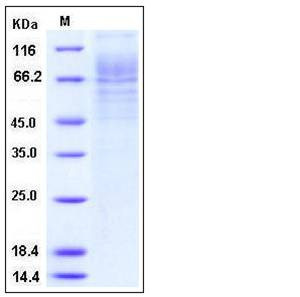Human Thrombopoietin / THPO / TPO Protein (His Tag)
MGDF,MKCSF,ML,MPLLG,THCYT1,TPO
- 100ug (NPP1691) Please inquiry
| Catalog Number | P10381-H08C |
|---|---|
| Organism Species | Human |
| Host | CHO Cells |
| Synonyms | MGDF,MKCSF,ML,MPLLG,THCYT1,TPO |
| Molecular Weight | The recombinant human THPO consists of 343 amino acids with the predicted molecular mass of 36.9 kDa. As a result of glycosylation, the apparent molecular mass of rhTHPO is approximately 60-80 kDa in SDS-PAGE under reducing conditions. |
| predicted N | Ser 22 |
| SDS-PAGE |  |
| Purity | > 85 % as determined by SDS-PAGE |
| Protein Construction | A DNA sequence encoding the human THPO (NP_000451.1) precursor (Met 1-Gly 353) was fused with a polyhistidine tag at the C-terminus. |
| Bio-activity | Measured in a cell proliferation assay using MO7e human megakaryocytic leukemic cells. The ED50 for this effect is typically 50-200 ng/ml. |
| Research Area | Cardiovascular |Blood |Coagulation |Coagulation Cascade |
| Formulation | Lyophilized from sterile PBS, pH 7.4 1. Normally 5 % - 8 % trehalose, mannitol and 0.01% Tween80 are added as protectants before lyophilization. Specific concentrations are included in the hardcopy of COA. |
| Background | Thrombopoietin (TPO or THPO), also known as myeloproliferative leukemia virus ligand (c-Mpl), is a hematopoietic growth factor belonging to the EPO/TPO family. The thrombopoietin protein is produced mainly by the liver and the kidney that regulates the production of platelets by the bone marrow. Thrombopoietin protein stimulates both proliferation of progenitor megakaryocytes and their maturation to platelet-producing megakaryocytes, and also accelerates the recovery of platelets. Thrombopoietin protein is involved in cardiovascular disease as it regulates megakaryocyte development and enhances platelet adhesion/aggregation. It has been identified that surface c-MPL, the receptor for thrombopoietin protein, binds to the ligand and mediates the action. |
| Reference |
